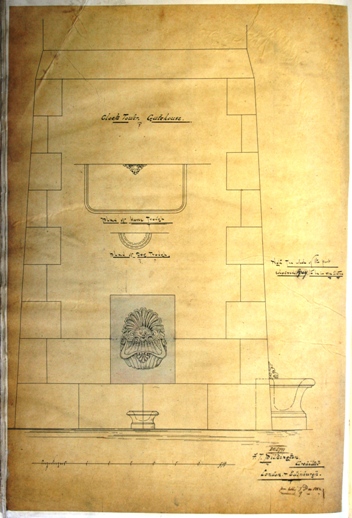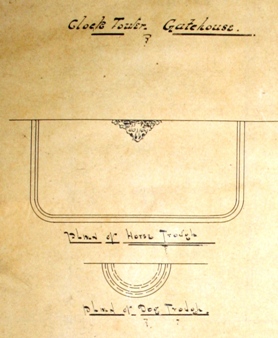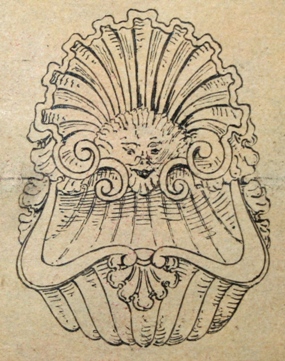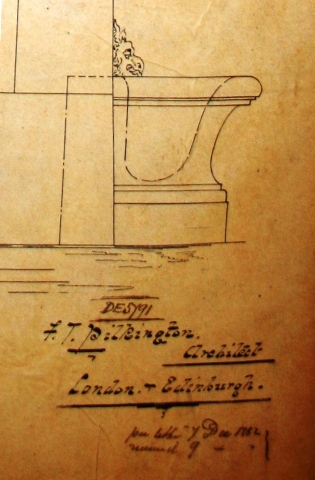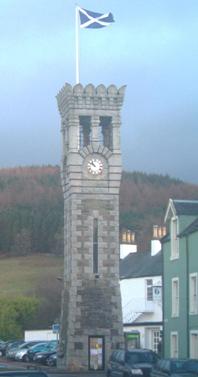 The clock and its tower were formally opened on Saturday 30th September 1871 and since then it has been a readily identified symbol of Gatehouse and forms the centre-piece of the Burgh Seal (and Crest). The tower is built of local whinstone with granite trim from Dalbeattie quarry, and it cost £300. The clock was made by Messrs. Gillett & Bland of Croydon, Surrey and cost £160, and wasdonated by Horatio Granville Murray Stewart of Broughton & Cally.
The clock and its tower were formally opened on Saturday 30th September 1871 and since then it has been a readily identified symbol of Gatehouse and forms the centre-piece of the Burgh Seal (and Crest). The tower is built of local whinstone with granite trim from Dalbeattie quarry, and it cost £300. The clock was made by Messrs. Gillett & Bland of Croydon, Surrey and cost £160, and wasdonated by Horatio Granville Murray Stewart of Broughton & Cally.
In 1867, at a time when the town did not have a Town Hall, the new Provost of Gatehouse, James McTaggart, suggested that a Town Clock be erected to give the Burgh a focal point. He offered to collect donations towards the cost. He sailed from Kirkcudbright to Liverpool on the 'Countess of Selkirk' to collect subscriptions from former Gatehouse folk who had relocated to that area. He also went on horseback to Edinburgh and Glasgow on similar missions.
(James McTaggart was a boot and shoemaker, born in Gatehouse about 1810)
Andrew Finlay, a watchmaker in the town, left a legacy of £30 towards the clock.
(In the 1861 census, Andrew Finlay was aged 49, born at Borgue)
In 1868 a Town Clock Committee was set up comprising Mr Murray Stewart (of Cally) in the chair, all members of the Burgh Council, plus Messrs Welsh (from Enrick), McCourty (from the Clauchan of Girthon), Hamilton (from Boreland of Anwoth) and David Kissock (from Rusko). An early decision of the committee was to choose the site, which is where it still stands, by the Murray Arms Hotel.
By September 1869 £313 had been raised, enough for the committee to place contracts.
Frederick Thomas Pilkington from the architectural firm Pilkington & Bell, Edinburgh was the chosen architect. He was well known for his design of churches and other buildings. The tower was to be 55 feet in height with each clock face being 3ft 6in diameter. The bell weighted 3½cwt and it was to be struck every hour and every half hour.
Mr John Cairns, the chosen builder, lived at Salamanca Cottage, Woodside Terrace. He was unwell by the time the project was finished, but it is said that he was pushed in his wheelchair to the door of his house to watch the tower being all-but finished. He died in August 1871, just before it was formally opened.
( John Cairns, born 1831, was a master builder, employing 12 men. He was also a member of the Town Council.)
The masons were the McGaws, almost certainly relatives of John Cairns, who was married to Jean McGaw.
(In the 1871 Girthon census, Robert McGaw snr. was a 53 year old mason who had a son Robert, aged 20, also a mason.)
Another mason, Mr McRoberts, (possibly Gordon McRoberts a 54 year old mason in 1881 census) was also employed on the building.
The Official Opening of the Town Clock took place at twelve noon on Saturday 30th September 1871. Mrs Murray Stewart pulled a cord to start the clock just before the hour.
In 1872 the gas meter for the town’s lighting was moved into the base of the clock from the cellar of a private house.
In 1883, after a piped water supply had been established in the town, Mrs Anne E. Murray Stewart presented a drinking fountain and a horse trough to be embedded in the clock tower. The fountain was cut from Dalbeattie granite with two bowls below for dogs. It bore the inscription ' he sendeth the springs into the valleys which run among the hills' - Psalm CIV v10. The horse trough bore the inscription 'A righteous man regardeth the life of his beast' - Prov. XII v10.
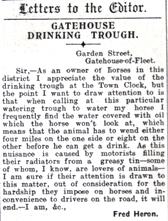
In November 1897, the Town Council Committee decided to obtain a Burgh Seal carrying as its device a representation of the Clock Tower and with the words 'Seal of the Burgh of Gatehouse of Fleet'. The Gatehouse Crest also shows a caricature of the clock tower.

In 1909, management of the Town Clock was handed to the Town Hall committee.
In 1923 Fred Heron wrote a letter of complaint that the drinking water in the horse trough was being contaminated by petrol from motor cars when the drivers used the trough to refill their radiators.
In 1926 David Manson became Burgh Officer and part of his duties were ' To take full charge of the Town Clock, to wind it up weekly, and oil and regulate the same. To keep the drinking fountains at the Town Clock clean and running properly'.
In 1934 local firm McMurray Bros. were paid 9s for repairs to the Town Clock.
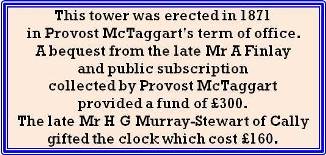
In 1940 the Town Council contemplated erecting a notice highlighting those involved in the erection of the Clock Tower. The words of the notice were agreed, but it was never fixed to the Tower. Information passed from Norah Henderson to David Gray, who is James McTaggart's great great grandson suggests that the notice might have contained the wording in the box to the left.
There was a complaint, in 1943, from members of the public that horses could not get to the drinking trough at the clock tower because of the number of parked cars. This led to removal of a car parking sign.
Peter Keddie was interested, as an amateur, in clock maintenace. He lived at Portville, was a town councillor for a number of years and personally repaired the town clock by making a replacement part in his workshop.
The clock was stopped in 1949 as different times were showing on all four faces causing great confusion. The problem seemed to be a badly leaking roof, leaving the mechanism open to the elements.
In June that year, a contract was approved for J&A Hunter, joiners, to replace the roof on the clock tower.
By the late 1950's the Clock was in need of repair, the flagpole and staging needed to be replaced, the bell had cracked, and its supports were unsafe. Various quotes were obtained and a new movement and striking mechanism together with a timer would cost £300. A new electric clock without a striker would cost £115.
Overhaul of the existing mechanism with the bell re-cast and a night-time cut-out would cost about £100.
The Council set up a Town Clock Restoration Fund and had the bell removed to safety on the ground floor. The fund raised £268.
In January 1960 the Council placed an order with John Smith & Sons, Derby to renovate the four dials and install a new clock for £325. John Smith bought the broken bell for £23. As a second phase, a new bell and striking mechanism would be installed later costing a further £200 or thereabouts. A new wooden flagpole was obtained.
As part of the Millennium Project in 2000, it is understood that a radio controlled clock with electronic chimes was installed. The chimes now only ring out the hour, half hour and quarter hours during the day time - except at Hogmanay when it is allowed to bring in the New Year at midnight.
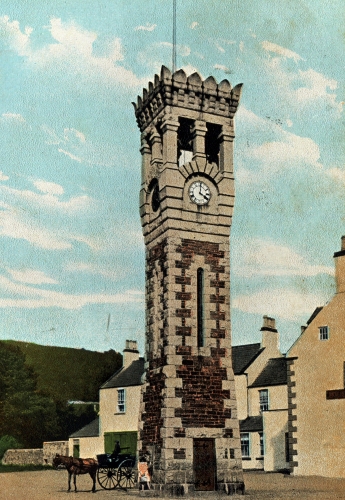
The following article about the building of Gatehouse Town Clock in 1871, appeared in the Galloway News 10th February 1922.
Gatehouse Town Clock By J. Stewart.
One of the most conspicuous objects in the “wee town of Gatehouse” is the clock tower, which, standing 55 feet high and in a prominent position at the head of the town, keeps watch and ward over its destinies. Natives regard it with peculiar pride for beneath its shadow have they not gathered in connection with events solemn and joyous in local and national history? And visitors from far and near take more than a passing interest in it because of its quaint appearance and its striking resemblance to a gigantic grandfather clock.
The idea of a clock for the town was first mooted by Andrew Finlay, a watchmaker, whose place of business was that house next door to the Union Bank on its upper side. He was eccentric in many ways and woe betide the man or woman who attempted to persuade him to open his shop before the dinner hour. His eccentricity notwithstanding, he took a keen and active interest in burgh affairs and being elected a councillor in 1852, became a junior bailie in 1854 and senior bailie in 1855.
When he died he left the magistrates and council of Gatehouse the sum of £30 for the purpose of erecting a town clock within the burgh. The matter was duly considered, and after setting aside a commencement of a fund towards the object the sum of £10, which had been received from Sir William Maxwell, as an ex
Accordingly they appointed a mew committee consisting of the Provost, Messrs McKean, Wylie, and McAdam, and co-opted Messrs Murray Stewart, Menzies, Campbell, McLean and Hall, the two latter being Andrew Finlay’s trustees. A draft circular explaining the object was sent out to natives and friends without the bounds, and Provost McTaggart and Messrs McAdam and Menzies called upon the inhabitants of the district. On April 9th 1868, when £140 had been received, it was decided to ask the road trustees to allow the clock to be erected in the Square between the Bank of Scotland and the Murray Arms. New developments, however, took place a month later. As some felt that such a sum was quite inadequate to provide a building worthy of the town on that site Mr Murray Stewart tabled a proposal to purchase Charles McMinn’s property – the Market Cross – and hand it over to the committee for the purpose.
The fat was in the fire immediately. The battle of the sites had begun. The committee was displaced by another, with Mr Murray Stewart as chairman and Mr Glover as secretary. The battle still raged and peace was not restored until the 4th of February 1869, when Mr Pilkington, an Edinburgh architect, and Mr Faed, the artist, strongly recommended as the best, the site at the head of the town.
Meantime the collectors had not been idle and had gathered in the sum of £313. They were further exhorted to duty and at the end of the year the Council not only paid over Sir William Maxwell’s £10, but also arranged a concert, which was a great success and which contributed materially to the funds.
It was not until the 28th of September 1970, that the way was made clear for the erection of a clock and tower in the town, the financial aspect being a great stumbling block. On that date, however, Mr Murray Stewart sent a letter to the clock committee in the following terms :- “I propose to withdraw my subscription of £50 and on condition that the tower is erected to my satisfaction and is proceeded with immediately, I will provide a suitable clock to be placed in it which I expect will cost from £100 to £120.” By this public spirited act of benevolence the committee were able to go ahead with the project and before the year ended working plans were prepared by Mr Pilkington free of charge, and estimates advertised for. When these came in they were found to be as follows :-
Robert Hume, Gatehouse ......... £435
D & D McCulloch, Whithorn ....... £1093
John Cairns, Gatehouse ........... £436 10s
These, however, were too high for the sum (£300) at the disposal of the committee and the plans were modified accordingly. A use was found for local stone in the structure instead of all granite as was originally proposed. Estimates were again called for and Mr John Cairns, proving the successful competitor, was entrusted with the work. But he did not live to see it finished – a strange coincidence when one considers that it had been prophesised that those employed on the job would be denied the pleasure of seeing its completion.
The prophesy, notwithstanding, the tower was built and the clock arrived. It was made by Messrs Gillet and Bland at Croydon, Surrey, and its movements are similar to those on the clock on the Houses of Parliament. The bell weighs 3½ cwts. and the dials are 3 feet 6 inches in diameter. After being duly placed in position the ceremony of setting it agoing was performed by Mrs Murray Stewart on Saturday 30th September 1871. Nearly all of Gatehouse turned out, amongst those present being Mr Murray Stewart, Provost McKean, Bailies McLean and McAdam, Councillors McHaffie, Hornsby, McLean and Belford, ex-Provost Campbell, Mr McTaggart, Mr H.D. Glover and Mr Pilkington, architect.
A cord attached to the pendulum was handed to Mrs Murray Stewart, who was sitting in her carriage, and that lady giving it a sharp pull at five minutes to twelve set the clock agoing and amid hearty cheers declared the tower opened. Thereafter the Gatehouse Brass band played “God save the Queen” and the proceeding terminated.
After the inauguration of the water supply into Gatehouse, Mr Murray Stewart with his kindly forethought and usual generosity provided the tower with a drinking fountain and a watering trough. Both were made of granite. On the inscription of the former are the words “He sendeth the springs into the valleys which run among the hills” and on the latter “A righteous man regardeth the life of the beast.” They have been of incalculable boon to tired man and weary beast. Drinking of their waters those have found refreshment and strength.
Long may the tower stand, the clock wag and the water run, to tell posterity of the public spirit of their predecessors. Fine illustrations those of that branch of learning called civics which is now being taught in our public schools. Gatehouse needs more than lip service to it natural beauties and attractions. It needs men who will do something with their wealth with which they have been blessed or their native place and improve the amenities of life in this remote corner of Galloway. A cottage hospital, a trained nurse, a public recreation ground, a club etc. would make the place more comfortable wherein to dwell and add to the zest of living. Who will be the benefactors?
The Troughs
The Clock Tower was built in 1871. After a public water suuply arrived in Gatehouse architect, F T Pilkington, was asked to draw up plans in December 1882 for the addition of a drinking fountain and water troughs for dogs and horses. These additions were completed in the summer of 1883. Plans are shown below :
Overall
|
|
|
Plan Detail of Troughs |
Drinking Fountain |
|
|
Horse Trough |
Our grateful thanks to Tommy Henderson of Dalbeattie Museum for letting us use these drawings.

